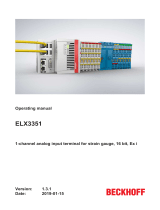Page is loading ...

GE Inspection TechnologiesGE Inspection Technologies
XrayXray
GEInspectionTechnologies.com
SEIFERT SABA 3000 P
Image Evaluation System for Unattended Radioscopic Inspection
Overview
The universal analysis of complex ra-
dioscopic images in batch inspection of
safety-relevant parts is a monotonous
and strenuous task whose outcome de-
pends on many subjective factors.
SABA 3000 P is a third-generation ima-
ge evaluation system to be applied in
fully automatic, unattended flaw detec-
tion and flaw analysis of cast parts.
Options
By its universal nature the PC-based
SABA 3000 P can be adapted to oth-
er inspection tasks as well, such as ful-
ly automatic completeness checks and
measurements of various patterns, e.g.
areas, sizes and distances.
Result-Dependent Test Extension:
To each test position can be assigned
further result-dependent test positions
whose number is subject to the number
of classified test regions.
We reserve the right to technical modifications without prior notice.
©2004 General Electric Company. All rights reserved.
GEIT-30010GB (3/04)
Technical Data
Control cabinet Window for inside monitor
Drawer for keyboard and mouse
Protection class IP 54
Dimensions 600 x 1600* x 600 mm (23.6 x 63* x 23.6”), (W x H x D)
*) If integrated in the control cabinet row of a complete
system, the height is 2000 mm (78.7”) or 2100 mm (82.7”)
SXGA monitor Screen diagonal 17"
Mains voltage 100-240 V, 50/60 Hz
Connected load 230 V ±10%, 50/60 Hz, 120 VA
Weight 18 kg (39.6 lbs)
Image processing system Type Industrial PC
Height 18 cm (7.1”) (4 HU)
Width 48 cm (19" plug-in)
Video input VIDEO signal (CCIR / NTSC selectable)
Video output VGA signal
Connected load 230 V ± 10%, 50/60 Hz, 180 VA
Weight 20 kg (44 lbs)
Full image resolution 738 x 570 pixel (CCIR)
Memory depth 8 bit (16 bits with integration)
Hard disk (capacities depending on availability)
3.5" diskette drive
CD-RW drive

GE Inspection Technologies
Xray
The SABA 3000 P image evaluation
system communicates with a program-
mable GE Inspection Technologies X-ray
Inspection System via serial interface or
digital lines.
If the radioscopic system includes a
recognition facility for parts and/or
moulds, SABA 3000 P will receive the
recognition outcome and determine the
inspection program accordingly. The
necessary test parameters will then be
given to the PLC.
Due to the smooth interaction of PLC
and SABA 3000 P the two tasks of po-
sitioning and image acquisition are
highly optimized and distinct from the
image evaluation task.
The image processing software detects
flaws according to given criteria and ar-
rives at a mode-specific test decision
either immediately (First Error) or at the
end of the entire inspection run. The
test decision triggers a sorting routine
via PLC.
SABA 3000 P features a simple proto-
col system. For each tested type it sta-
tistically records data on the number
of tested parts. The statistical counters
can be reset after entry of a password.
If required, the test results can be
transferred to PRODAT, a separate pro-
tocol system, for processing and statis-
tical analysis.
Both the test parameters of the radio-
scopic system and the instructions for
the image processor are part-specif-
ic. They must be established in the so-
called set-up mode through parameter-
ization not only to ensure a test sensi-
tivity sufficiently high to meet a cus-
tomer’s test specifications, but also to
prevent false detections. The parame-
terization process is completely menu-
controlled. It requires little knowledge
of the system, but inspection experi-
ence is a must.
The SABA 3000 P image evaluation
system can be adapted to all those
parts with a defined structure whose ra-
dioscopic image can be evaluated visu-
ally as well.
Deviations in structure that exceed the
usual casting tolerances cause false de-
tections. Thus, in the set-up mode, sys-
tematic deviations in structure such as
variations on patterns have to be as-
signed a part number of their own.
Non-systematic deviations in structure
such as burrs, flashes and seams have
to be removed through adequate fet-
tling.
Visual Re-Analysis / Re-Decision
The operator can visually monitor crit-
ical test situations. When all test po-
sitions have been processed by SABA
3000 P, each REJECT image is dis-
played for visual re-analysis so that the
operator can
either override or confirm the initial
SABA 3000 P decision.
Recursive Parameterization
All REJECT positions can be stored by
SABA 3000 P. The images thus stored
can be checked and their parameteriza-
tion be adjusted by the operator. This
function can also be performed by an
off-line SABA image evaluator if system
down-times are to be avoided.
The combination of radioscopic facility
and SABA 3000 P image evaluator con-
stitutes an autonomous inspection sys-
tem that under routine conditions per-
forms without any operator control.
During operation, the performance of
the inspection system is periodically
checked by an image quality test and a
positioning test.
The image quality test checks the entire
image-generating chain by comparing a
particular live image with a stored refer-
ence image.
The positioning test aligns the handling
system in a given position to produce a
certain test pattern which has to fulfill
definite criteria.
As long as the test results remain within
a given tolerance range, routine inspec-
tion continues. If they exceed the upper
or lower limits, an error message causes
discontinuation of the inspection
process.
Basic equipment 1 19" plug-in unit with image processing hardware
consisting of
Dual XEON ≥ 2,0 GHz)
512 MB RAM, Network adapter card,
Hard disk (min. 20 MB), FD drive,
CD-RW drive, Keyboard and mouse
1 SXGA control monitor 43 cm (17")
1 Set connecting cables
1 SABA 3000 P operation program
consisting of
- Communication
- Flaw detection
- Classification
- Recursive parameterization
- Visual re-analysis / re-decision
1 Parameter set for 1 test sample
Options - Result-dependent test extension
- SABA 2000 XRC (X-ray Character Recognition)
- Integrated measurement functions
- Video-optical positioning
Description Delivery Scope
/

